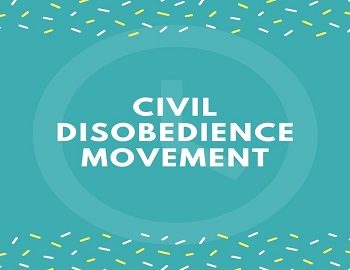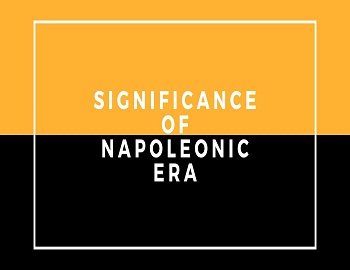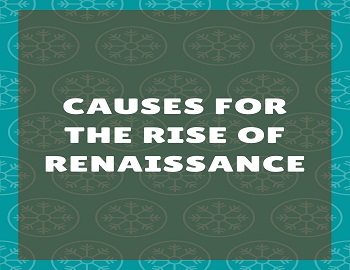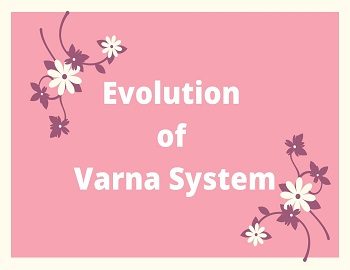Renaissance:
The period between the fifth and the sixth centuries A.D. was known as the ‘Dark Age‘ in Europe. Lawlessness prevailed all over the continent. People believed in the absolute authority of the Church and accepted everything blindly. But by the fourteenth and the fifteenth centuries, a change began to take place. A new era started in Italy known as Renaissance which means rebirth. It actually signified the rebirth or revival of the old cultures and learning- the Greek and the Roman cultures and the pre-Christian culture. There were many reasons for the advent of the Renaissance. Firstly, the crusades brought the Europeans into contact with the Arabs who were then considered to be an advanced race. Secondly, many new trade routes were discovered. There was a spirit of enquiry amongst the people. Thirdly, the study of the literature, history and philosophy of the ancient cultures also broadened the narrow outlook of the people. The educated people began to question the existing religion, society and laws and refused to accept the answers given by the Christian Church. People began to reason and believed more in what they actually saw and felt rather than what the priests told them. Men developed many of the qualities of mind which we associate with the modern way of thinking.
An important feature of this movement was that it preached humanism. Uptil now the Pope and the King had been the most important people and the common folks had to lead their lives according to their wishes. Anyone who dared to speak against the Pope was severly punished. But now, religion, heaven and hell gradually became insignificant for man. He became the centre of study. Every man was considered important and treated with respect.
The ideas of the learned men developed in great contrast to those of the Church. The scholars sought a scientific reason for everything happening around them. Copernicus (1473-1543), a Polish astronomer, proved by mathematical calculations that the sun is the centre of the universe and is stationary. The earth and the other planets move around it. This was, however, only a theoretical assumption. But sometime later, an Italian astronomer, Galileo (1564-1642), proved the same through observation and experiment. He observed the planets and the sun through an instrument called a telescope. This shattered the popular Christian belief that the sun moves around the earth. The Church felt that their authority being challenged. Galileo was forced to admit that his theory was incorrect. Newton (1642-1727) concluded that the movements of all celestial bodies were controlled by gravitation. With the new astronomical knowledge that was available, the old Julian calendar was reformed in 1582 by Pope Gregory XIII. The humanistic spirit of the Renaissance had also awakened increased interest in the study of medicine and anatomy. Vesalius (1514-1564), a Netherlander wrote a treatise on human anatomy. William Harvey (1578-1657) discovered the blood circulation, a prime contribution to medical science.
The other characteristic of the Renaissance is that the ideas of Ancient Greek and Roman philosophy were incorporated in contemporary architecture. Florence, Rome and Venice became the centres of the architecture of intellectual Renaissance age. Filippo Brunelleschi was the first artist who began this architecture in Florence. Medici Church of Florence is a fine specimen of this art. In this tower, the ancient architecture has been presented in a new style but this architecture actually flourished in Rome. St. Peter’s Church at Rome was built by an artist named Bramnate which highlighted the climax of this type of architecture. This Church is very beautiful. Scholars like Raphel, Michelangelo etc. contributed a lot to the development of architecture. This art developed in France and Spain during the reign of Francis I (1515-1547), and Philip II (1556-1598) respectively. Both of them were great patrons of art. In England, this art flourished in the 17th century.
Artists like Leonardo da Vinci painted a subject after close study and observation. Therefore, his paintings appear to be life-like. He is best remembered for his paintings like the portrait of Mona Lisa and the Last Supper. Besides being a painter, he was also a musician and a scientist. Raphael’s self-portrait, Madonna and the child and Michelangelo’s Last Judgement are important pieces of art.
Poets and dramatists like Shakespeare and Milton enriched English literature with their works. They took the life and problems of the common man rather than religion and gods, as the theme of their works.
Thus, the Renaissance encouraged free thinking and reasoning in man who now refused to accept the authority of the clergy and freed himself from the shackles of religion. His eager mind set about to explore new things and to take long strides towards the modern age.









Comments (No)